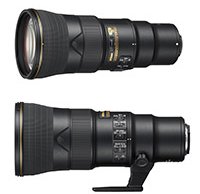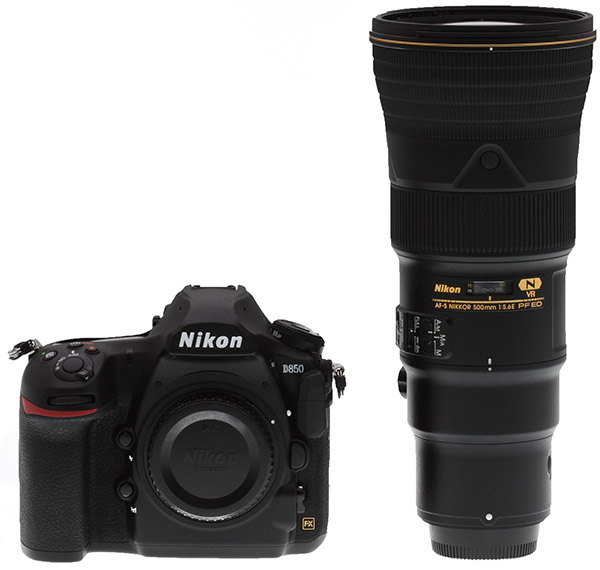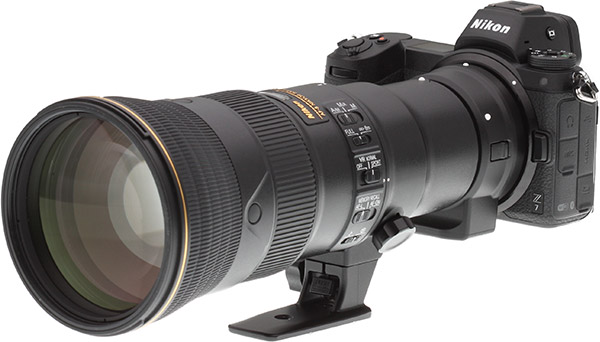The super-small supertele: Nikon’s new 500mm f/5.6E PF telephoto lens seems impossibly small
posted Thursday, August 23, 2018 at 1:01 AM EDT

In June, Nikon announced the development of a new AF-S Nikkor 500mm f/5.6E PF ED VR fixed focal length super-telephoto lens. At the time, there was not a lot of information available aside from the lens being designed to be compact and lightweight and that it would utilize a Phase Fresnel (PF) lens element. We now have a full rundown of features, specifications and availability information for you, so let's dive right in!
The Nikon 500mm f/5.6E PF lens has a maximum diameter of only 4.17 inches (106 millimeters) and is 9.3 inches (237 millimeters) long. Compare these dimensions to Nikon's 500mm f/4E lens, which has a maximum diameter of 5.5 inches (140 millimeters) and is 15.2 inches (387 millimeters) long, and you'll get a feel for the stunning difference. It is not only the volume of the lens that is much less, but also the weight. The 500mm f/5.6 weighs 3.2 pounds (1.46 kilograms) versus 6.8 pounds (3.09 kilograms) for the 500mm f/4E. To put it another way, the 500mm f/5.6E PF lens weighs roughly the same as Nikon's latest 70-200mm f/2.8 lens. Nikon hopes that the compact and lightweight nature of the new 500mm lens will make hand-held, super-telephoto photography an easier and more enjoyable experience than has been previously available.

In the pursuit of a lightweight design, Nikon has fortunately not skimped on weather sealing. You will notice the gold ring around the barrel, which represents a high level of precision and build quality for Nikon optics. The lens has dust- and drip-resistance and has a fluorine coating on the front element. Additional aspects of the optical design include one PF lens element, three ED glass elements and Nano Crystal Coating.
Looking closer at the PF element, it is a Nikon-developed element which compensates for chromatic aberration via the photo diffraction phenomenon. When waves of light encounter an obstacle, they try to bend around the obstacle, which is diffraction. Diffraction causes chromatic dispersion in the reverse order of refraction. Basically, light travels through typical refractive lens elements and PF lens elements in different ways and when you combine the two elements together in the right way, you can effectively reduce chromatic aberration through a mutual cancellation. By using elements to cancel each other out, so to speak, Nikon is able to reduce the number of lens elements needed to produce a high image quality.

To aid in fast autofocus speeds, the focusing elements have also been designed to be particularly lightweight. The lens also features Vibration Reduction which is rated for up to four stops of shake correction. The lens includes a Sport VR mode, which is designed to offer further stabilization for the viewfinder, allowing easier tracking of moving subjects, such as when photographing wildlife or sports. Additional features include an electromagnetic diaphragm for precise aperture control and compatibility with Nikon's TC-14E III teleconverter.
Nikon points out that the lightweight lens will make a good pairing with the newly-announced Nikon Z6 and Z7 mirrorless cameras as well via the FTZ adapter. That will certainly be a considerably more compact super telephoto full-frame shooting setup than anything Nikon has ever offered before!

Nikon will release the Nikkor AF-S 500mm f/5.6E PF ED VR lens on September 13th for a suggested retail price of $3,599.95. There will also be an optional Dot Sight DF-M1 accessory available separately, which will make it easier to track a moving subject at a distance. This accessory will cost $174.95. Stay tuned as we'll have you much more coverage from this exciting lens as it becomes available.